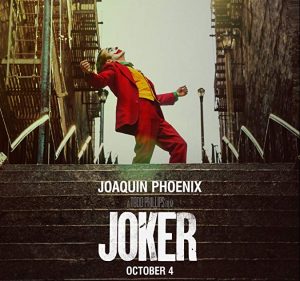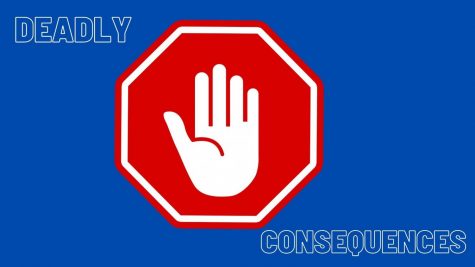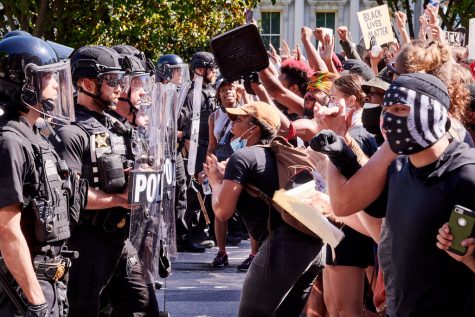Low Rating

Movie poster for Joker.
October 16, 2019
From the perils of Gotham, Todd Philipps’ Joker portrays an alternative version of Batman’s arch nemesis.
In the film, Joker is played by Joaquin Phoenix, whos’ identity in this film is Arthur Fleck a failure of a comedian in the shadiest parts of Gotham. The story is told through the perspective of Fleck as his sanity is slowly deposited throughout the film. The first notation that this movie’s portrayal of Joker will be significantly different occurs in the opening scene where Joker is in front of a mirror mimicking the signature sinister smile that Joker is known for. In terms of plot, the movie is successful in separating Fleck and Joker as two separate individuals, where Fleck assumes the latter at the climax of the film.
The movie then transitions into an office with Fleck and his Social Worker Debra Kane played by Sharon Washington. In this scene Fleck appears to be crying and laughing as he attempts to speak to Kane who appears disinterested and apathetic to Fleck’s breakdown. The distinct contrast between Kane and Fleck heightens the boundary set between the individuals who only have a desk separating them.
From the opening scene Fleck is then transferred to the front of a shop where he performs his act as a dancing clown to advertise a sale. During which a group of adolescent boys robs Fleck of his sign sending him on a spree to retrieve the sign, the scene however does reveal a telling aspect of the society that Fleck lives in. In his chase, Fleck screams for assistance however the other individuals that observe the pursuit do nothing to help Fleck creating a theme of isolation and despair. What should also be noted for later is the eroded components of the city, as the movie progresses the city appears to get murkier as Fleck assumes the identity of Joker.
Turning the corner Fleck is struck with the sign causing him to fall and the pack of boys begins to beat Fleck into submission. One of the smaller notations of this scene that is the hesitation the smallest boy of the group experiences when the others begin brutalizing Fleck. This embrace of violence is shown throughout the film showing the devolution of society in the face of protest. As Fleck lays on the ground helpless the idea of submission depicts that this type of violence has been a routine part of his life as he shields his neck rather than his face a hallmark of prioritizing defense.
On his return to the place of his employment he is given a gun by a coworker who instructs him to use it for self-defense given the time period. As Fleck continues to devolve the significance of the gun changes as the movie progresses. Aboard a subway Fleck still in clown uniform shoots 3 passengers who attempted to brutalize him once more. Fleck’s initial reaction to the killing directly contrasts his almost frightened nature towards the gun in an earlier scene. As Fleck chases another one of the passengers from the subway, he shoots the gun without hesitation and proceeds to run into the night.
As word of his crime spreads Fleck gradually transitions to Joker, a man without hesitation for killing and acceptance for what is described as his ‘condition’. Fleck then proceeds to kill the coworker who gave him the gun in front of another coworker showing that his killing only applies for what is necessary, rather than brute force and retaliation. It is also at this point that Fleck dives into an identity crisis believing that Thomas Wayne is his father according to his mother who is also mentally ill. However, it is revealed after Fleck steals his mother’s records that she was brutalized by her ex-boyfriend and was only employed for Wayne but began obsessing about him which is shown in all the scenes that she is present in.
Gotham at this chapter has then ensued into chaos where protesters wearing the sinister clown mask begin to riot against an unequal society that Fleck has officially adopted the identity of Joker and kills his role model Murray Franklin, played by Robert De Niro on live television. The city is then catapulted into disaster as Joker is whisked away by a police car observing the chaos with his signature laugh. During the resolution it appears Joker will be taken to jail but as the car crosses an intersection it is hit with a truck and Joker is swarmed pulled from the car hoisted into the arms of the rioting civilians.
A hallmark scene for many who watched the film was the depiction of Batman’s parents being murdered heightening the complex relationship between Joker and Batman and the opportunity to continue the franchise based on this timeline.
Throughout Joker the acting for the film is decent, however, the delivery of the scenes organizationally does raise greater critique. At one point it is revealed that the sequence the Joker had with his love interest was just a facade, making the delivery almost comedic and extremely predictable. The almost lazy directing of the scene does not raise questions as to what is happening and lulls the audience into the predictability as one of the most cheesiest aspects of the film.
Another disappointing feature of the film is the constant necessity for reveal after reveal and retracting information that Joker learns. While this element is used to describe Joker having no true identity other than the one he has constructed Phoenix’s sloppy work during the scenes does not gravitate some to continue watching.
The film did however create some grotesquely gory scenes, which were perfectly executed, had the movie set this as the entire tone of despair and isolation it would have complimented the ironic tones much more. Having the contrast between the comedic undertones and depressing sequences would have created a stronger film and a more impactful Joker.
Given the critiques the movie did receive controversy for its portrayal of mental illness and its correlation to violence. The commentary does hold some value, considering the design of the film where without medication Fleck becomes Joker, which may be isolated as an interpretation of mental illness. Where the critique lacks value is the expression that is advocates those who are mentally ill as violent, the reason Joker is violent is in defensive scenes not for the sake of his devolving sanity. Another aspect of the film that garnered controversy was its violence, however as a viewer who prefers gore or a classic thriller the movie did deliver beautifully in that setting, although it’s not the first gory film to exist either.
Although Philipps interpretation of the film is unique the movie does fall short in more than one ways. While some find the cheesy qualities as a strong focal point the movie did fall short in delivering crucial aspects of Flecks transition to Joker.
Overall: 5/10








